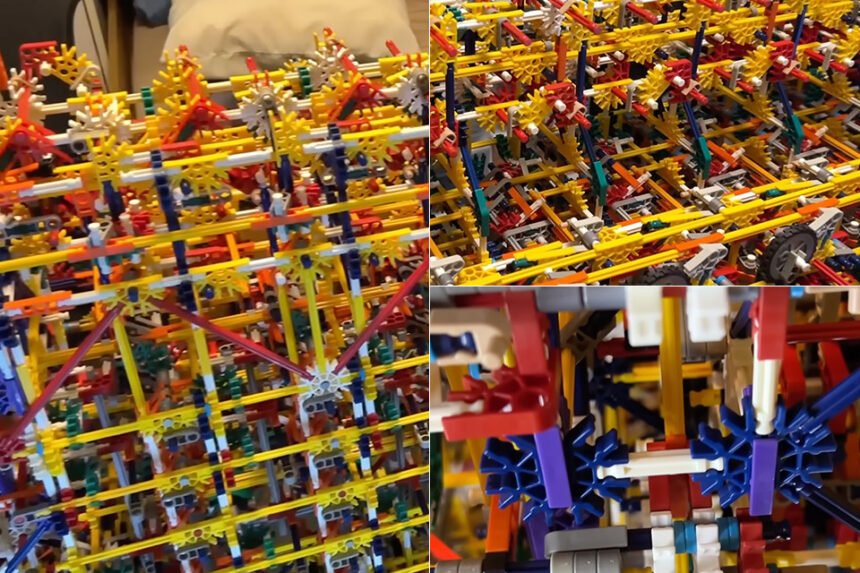Shadowman39’s Innovative 8-Bit Knex Mechanical Computer: A Nostalgic Leap into Computing
In an era dominated by advanced silicon-based technology, a unique project is capturing the imagination of tech enthusiasts and nostalgic builders alike. Shadowman39, a creator known for his inventive spirit, is constructing a mechanical computer entirely from Knex, the colorful plastic construction toy that many remember fondly from their childhood. His latest video showcases significant advancements in his 8-bit mechanical computer project, blending creativity with engineering ingenuity.
The Basics of 8-Bit Computing
At the heart of Shadowman39’s creation lies the concept of 8-bit computing. This architecture processes data in groups of eight binary digits, or bits, allowing for a range of values from 0 to 255. When considering signed integers, the range extends from -128 to 127. The latest update focuses on the computer’s registers and RAM, which serve as the machine’s memory and data staging areas. Registers are temporary storage units that hold numbers for the arithmetic logic unit (ALU) to process. Shadowman39’s design includes three registers: two primary ones, A and B, and a sum register that retains the ALU’s output.
Each register is ingeniously designed to hold an 8-bit value using levers that physically represent binary states-pushed one way for a 1 and the other for a 0. This hands-on approach allows Shadowman39 to manually debug the system by flipping these levers, although the computer is ultimately designed to automate operations and run programs independently.
Understanding RAM and Its Functionality
Random-access memory (RAM) plays a crucial role in computing, acting as a larger-scale counterpart to registers. Shadowman39 has constructed two 8-bit RAM modules, with plans to expand this to eight. The RAM utilizes a flip-flop method, where a physical component toggles between two positions to represent binary values. While both RAM and registers serve similar purposes, Shadowman39 notes that the RAM employs a fifth-generation design that simplifies data operations compared to the register versions.
The Data Bus: A Conduit for Information
Central to the operation of this mechanical computer is the data bus, composed of eight vertical rods that facilitate the transfer of 8-bit values between RAM, registers, and other components like the ALU. To read data, a register or RAM module pushes its stored bits onto the bus, raising the rods for 1s and lowering them for 0s. Conversely, writing data involves the destination register or RAM reading the bus and adjusting the rods accordingly. This process is powered by two motors-one dedicated to reading and the other to writing-each completing a full 360-degree cycle in approximately three seconds. The motors are interconnected through gears to ensure precise timing, with a slight delay in the write action to prevent data conflicts.
Mechanical Selection: A Clever System
Choosing which register or RAM module to read from or write to requires a sophisticated mechanical selection system. For the registers, a simple swivel linkage is employed to select between A, B, or the sum register. However, the RAM necessitates a more intricate solution. Shadowman39 utilizes a 4-to-16 selector, a mechanical decoder that uses four input bits to select one of 16 outputs, even though only eight are needed for the proposed RAM stack. Each output corresponds to a specific RAM module, and the selector is designed to ensure that only one module is active at any given time. By converting input bits into binary values (e.g., 0001 for the second RAM slot), the selector physically contacts the desired module, allowing for precise data access.
Automation: The Heart of the System
Automation is the linchpin that ties all components together, transforming the computer into a self-operating machine. The read and write motors at the base of the computer are continuously spinning but only engage when necessary, thanks to a clutch-like transmission arrangement. Currently, Shadowman39 manually sets the control lines, but future plans include replacing this with instructions stored in read-only memory (ROM). This ROM will be designed similarly to the RAM but will only read pre-set instructions, enabling the computer to run programs and function as a fully programmable machine.
A Nod to the Past: The Significance of Knex in Modern Computing
The use of Knex in this project is not merely a nostalgic choice; it also serves as a testament to the enduring appeal of hands-on learning and creativity in technology. Knex, which gained popularity in the 1990s, has been a staple in educational settings, promoting STEM (Science, Technology, Engineering, and Mathematics) skills among children. By utilizing this construction toy, Shadowman39 is not only reviving childhood memories but also inspiring a new generation to explore the fundamentals of computing and engineering.
Comparative Insights: Mechanical vs. Electronic Computers
Shadowman39’s mechanical computer stands in stark contrast to modern electronic computers, which rely on silicon chips and complex circuitry. While electronic computers can process vast amounts of data at incredible speeds, mechanical computers like Shadowman39’s offer a tangible understanding of how data is manipulated and stored. This project serves as a bridge between the past and present, illustrating the evolution of computing technology while emphasizing the importance of foundational concepts.
Conclusion: A Unique Blend of Creativity and Engineering
Shadowman39’s 8-bit Knex mechanical computer is more than just a nostalgic project; it represents a unique fusion of creativity, engineering, and education. By building a functioning computer from a construction toy, he is not only pushing the boundaries of what is possible with Knex but also encouraging others to engage with the principles of computing in a hands-on manner. As he continues to develop this innovative machine, the project serves as a reminder of the joy of creation and the endless possibilities that lie within the world of technology.











